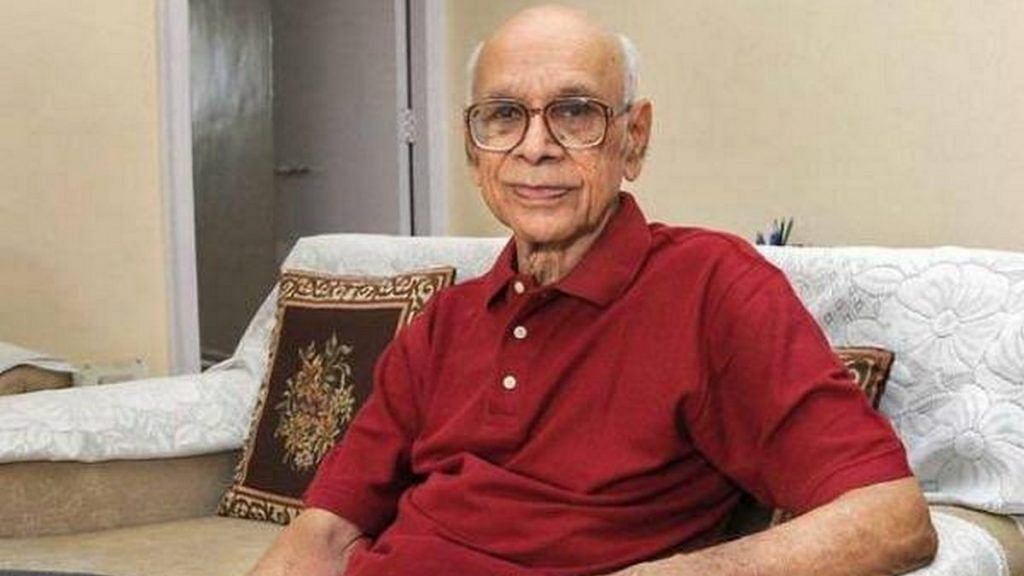New Delhi: Stingy. Frugal. Dour. ‘Khadoos’. Those are the epithets widely applied to the career of left-arm spinner Bapu Nadkarni, who passed away at the age of 86 in Mumbai Friday.
Rameshchandra Gangaram Nadkarni was no ordinary cricketer. In a day and age when the pace of the game has quickened up so much that one rarely sees a Test match last the full five days, his numbers make for some mind-boggling reading — his economy rate over 41 Test matches was 1.67. While he played in the 1950s and 1960s, when four-an-over scoring was still a few decades away, he still finished with the fourth best economy rate for anyone in history who bowled more than 2,000 balls.
Nadkarni was even stingier in first-class cricket, where his economy rate was 1.64 an over in more than 10,000 deliveries, according to a Board of Control for Cricket in India press release condoling his death.
Frugality was such a defining characteristic of Nadkarni that his 88 Test wickets, 1,414 Test runs, one Test century, 500 first-class wickets, 8,880 first-class runs and a first-class average of 40.36 are mere afterthoughts.
Also read: Feared fast man returns: How a fit Bumrah is adding new missiles to his deadly arsenal
The 21 maidens
Nadkarni’s ESPNCricinfo profile gives a snapshot into his miserliness — against Pakistan in 1960-61, his figures were 32-24-23-0 in Kanpur and 34-24-24-1 in Delhi. But his most famous spell was 32-27-5-0 against England in Madras (now Chennai) in 1964, which included 21 maiden overs in a row — even today, it is a record for most maidens in succession for six-ball overs.
The outpouring of tributes to him on Twitter attests to just how famous that spell is — from Sachin Tendulkar to Vice-President M. Venkaiah Naidu’s secretariat, many mentioned it as what they remember him by.
Deeply saddened to learn about the demise of Well-known cricketer and All-Rounder Bapu Nadkarni. He will be best remembered for bowling 21 consecutive maiden overs against England in a Test match in Chennai. My condolences to bereaved family members pic.twitter.com/MjYMWXt4hc
— Vice President of India (@VPSecretariat) January 18, 2020
Nadkarni played until the 1967-68 season, when despite being dropped for India’s tour of England, he was recalled for the tour of New Zealand that winter, and took a career-best haul of 6 for 43 in Wellington. However, with Bishan Singh Bedi emerging as the left-arm spinner of choice for the national team, Nadkarni announced his retirement soon thereafter.
Later in life, he served as a national selector and an office-bearer of the Bombay Cricket Association (now Mumbai Cricket Association).
Epitome of ‘khadoos’
Journalist Rajdeep Sardesai, whose father Dilip Sardesai played alongside Nadkarni for Bombay and India, used the word ‘khadoos’ in his tweet to describe him.
He once bowled 21 maiden overs in a row.. was a dour, determined batsman who never flinched .. ‘khadoos’ is the best way to describe Bapu Nadkarni who passed away today.. part of the great Mumbai generation of the 50s and 60s RIP
— Rajdeep Sardesai (@sardesairajdeep) January 17, 2020
The word generally has negative connotations, with the Collins dictionary translating it as ‘lout’ — a rude or aggressive person.
However, in Bombay (now Mumbai) cricket, ‘khadoos’ has been the ultimate compliment, reserved for the most never-say-die players. The team’s 41 Ranji Trophy titles and 14 Irani Cups are littered with examples of ‘khadoos’ players who dug in and got the team the necessary results — former India opener Wasim Jaffer and the obstinate style of play that made him the top run-scorer in Ranji history being a prime example from recent decades.
Nadkarni didn’t play his entire first-class career with the Bombay team; he initially played for and captained Maharashtra. But hardly anyone epitomised ‘khadoos’ more than the man called ‘Bapu’.
Sunil Gavaskar, one of India’s greatest cricketers, rose through the same ‘khadoos’ culture, and though he didn’t play alongside Nadkarni, the former Indian captain recalled the time the latter spent with the team as assistant manager on a few tours. Gavaskar told reporters on the sidelines of India’s second ODI against Australia in Rajkot that Nadkarni’s “favourite term where we all learnt from was ‘chhodo mat’ (don’t quit)”.
“He was gritty despite playing in the days when gloves and thigh pads were not very good, not much protective equipment as you would get hit, but still hang in there as he believed in chhodo mat. You are playing for India. That thing we learnt from him,” Gavaskar said.
Former Bombay captain Milind Rege also recalled Nadkarni’s ‘khadoos’ quality, with ESPNCricinfo quoting him as saying: “The khadoos thing that applies to Mumbai cricket, he would be right at the top. He was not a stylish player at all…[but] he just would not give anything away, he was that khadoos.”
But off the field, there was nothing about him that could be called ‘khadoos’. Cricketers describe him as a thorough gentleman and helpful to youngsters, with current India head coach Ravi Shastri tweeting fondly about him as his first team manager.
My heartfelt condolences to the bereaved family & friends of Bapu Nadkarni ji. One of our finest and my first team manager. RIP Sir. Om Shanti ? pic.twitter.com/Z17EqpO1W9
— Ravi Shastri (@RaviShastriOfc) January 18, 2020
Nadkarni was more than the sum of his bowling accuracy and maiden overs. In the words of Gavaskar, “Indian cricket has lost a real champion”.
Also read: MS Dhoni dropped from BCCI’s central list of contracted players
